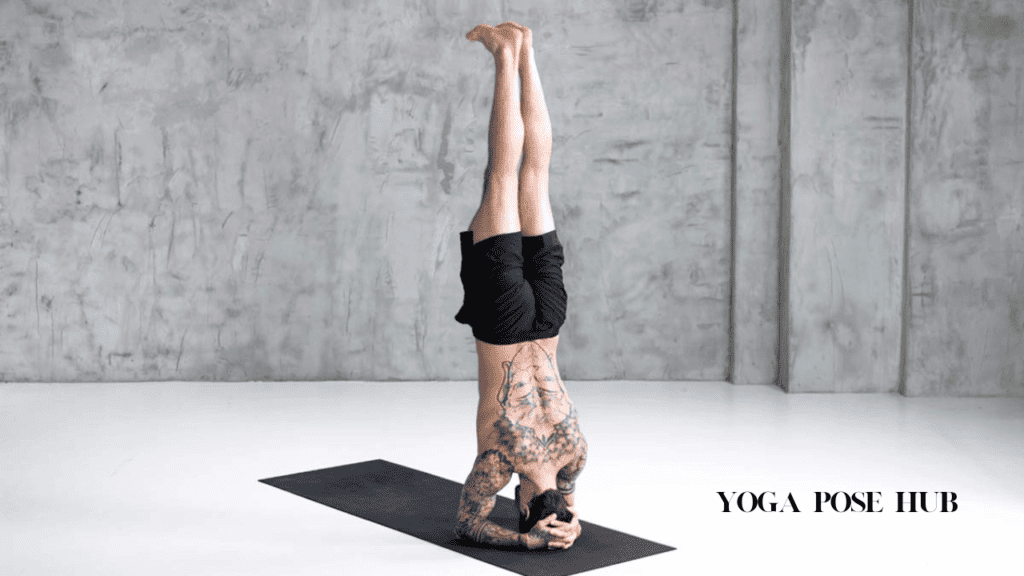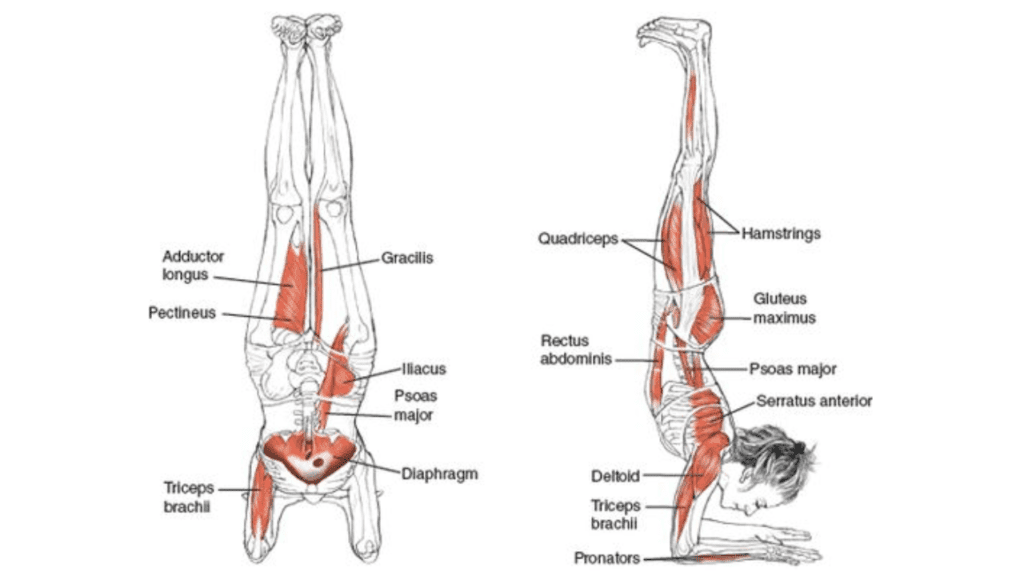Ready to take your yoga exercise to the subsequent stage? The head yoga pose, or Sirsasana, is an effective pose that strengthens your frame, sharpens your consciousness, and boosts your confidence. Often referred to as the “king of all poses,” headstands are extraordinary for improving stability, mental readability, and normal well-being. Whether you’re a pro yogi or simply starting your journey, gaining knowledge of the headstand is a profitable challenge. In this guide, we’ll destroy it step by step so even an amateur can feel confident giving it an attempt. Let’s dive in!
Target: Head

What is a Head Yoga Pose?
The headstand is a traditional yoga pose wherein you balance your frame for your head, the usage of your palms to guide yourself. This inversion flips your world the other way up, actually and figuratively, selling physical power and mental calm. While it would seem intimidating initially, with the proper guidance and practice, it’s a pose everybody can master.
Warming up Before Yoga
Warming up before yoga is crucial for getting your body ready and preventing harm. A proper warm-up increases blood glide to your muscle tissues improves flexibility, and helps lighten up tight regions. Simple stretches like neck rolls, shoulder shrugs, and cat-cow stretches can lightly awaken your joints and backbone. This gets your frame ready for extra extreme poses while reducing the hazard of stress. Always take a couple of minutes to ease into your exercise—your frame will thank you!
How to Prepare for a Headstand
Before diving into the total headstand, it’s important to heat your body and construct strength in key areas:
- Strengthen the center with plank poses.
- Build arm and shoulder balance with the use of a dolphin pose or downward canine.
- Practice wrist and neck stretches to keep away from harm. Always begin sluggish and make sure you’re in a secure area to practice, preferably with a wall in the back of you for help.
Step-by-Step Guide to Head Yoga Pose
Start in Child’s Pose: Kneel on the floor and relax your brow on the mat, extending your fingers forward.
- Create a Tripod Base: Place your forearms on the ground, clasping your fingers collectively to form a stable triangle. Your head should relax lightly on the mat among your fingers.
- Lift Your Hips: Slowly raise your hips into the air, on foot, your feet toward your palms till your frame forms an upside-down ‘V’.
- Lift One Leg: Gently improve one leg toward the ceiling, retaining your center engaged.
- Find Balance: Once snug, raise the second leg and straighten both in the air.
- Hold and Breathe: Keep breathing deeply as you maintain the pose for 10-20 seconds, then slowly decrease your legs and return to the mat.
Curious about more yoga poses? Check out our detailed guide on “Eye of Needle Yoga Pose” for another enriching addition to your practice!
Benefits of the Head Yoga Pose
Why ought to you study this pose? The blessings cross past just bodily fitness. The headstand helps to:
- Improve flow by encouraging blood glide to the mind.
- Strengthen the middle, shoulders, and fingers, as they play a first-rate role in balance.
- Enhance cognizance and attention, when you consider that balance calls for mental clarity.
- Boost your temper through liberating endorphins due to the inverted function. These notable perks make it a should-try for any yoga fanatic.
Common Mistakes to Avoid
When studying the head yoga pose, it’s easy to make a few mistakes that can throw off your stability or result in discomfort:
- Not engaging the center: A strong middle is prime to retaining your body stable.
- Pressing an excessive amount of weight for your head: Your fingers have to be doing maximum of the paintings, no longer your neck.
- Rushing into the pose: Take a while. Proper alignment is important for success and protection.
Modifications for Beginners
If you’re new to the headstand, it’s totally k to modify the pose:
- Use a wall for support till you sense cushty balancing to your very own.
- Start with 1/2-headstands, wherein the handiest leg is lifted, allowing you to build power and confidence gradually.
- Try a headstand bench or props that take the strain off your neck.
Curious about more yoga poses? Check out our detailed guide on “Peacock Pose Yoga” for another enriching addition to your practice!
Safety Tips for Practicing Headstands
Safety ought to continually come first while studying any new yoga pose, particularly inversions:
- Never force the pose: If you sense soreness or pain, stop immediately.
- Avoid practicing headstands when you have neck or returned injuries.
- Use a yoga mat or padding to defend your head and wrists.
When Should You Avoid Headstands?
While the head yoga pose has lots of blessings, there are instances while it’s first-class to avoid practicing:
- If you have high blood stress or a heart circumstance.
- If you’re pregnant or in the menstrual cycle, inversions can disrupt blood glide.
- If you’ve got severe neck or again issues.
Transitioning to Advanced Inversions
After studying the top yoga pose, you would possibly feel prepared to strive for different advanced inversions, like:
- Forearm stands A tremendous next step for top body strength.
- Handstands: The last venture in balance and core energy.
Curious about more yoga poses? Check out our detailed guide on “Eye of Needle Yoga Pose” for another enriching addition to your practice!
Head Yoga In Your Daily Routine
Incorporating head yoga poses into your everyday ordinary can convey mental and physical advantages. Poses like the Headstand (Sirsasana) enhance blood circulation to the brain, enhancing cognizance, relieving pressure, and boosting electricity ranges. Regular exercise strengthens your top body, improves stability, and builds center balance. Adding this pose to your recurring not handiest demanding situations your body however additionally calms your thoughts, selling overall well-being during the day. Just a couple of minutes every day can result in lengthy period upgrades in both energy and mental readability.
Target Points

Conclusion
- Boosts physical and mental strength.
- Improves stability and coordination.
- Reduces strain and enhances focus.
- Strengthens the core, palms, and shoulders.
- Promotes blood to go with the flow to the mind for mental clarity.
With persistence and ordinary exercise, the top yoga pose can end up an effective addition to your yoga ordinary. So, are you ready to flip your global the wrong way up? Give it an attempt, and allow the blessings to unfold!
Frequently Asked Question
Is the headstand safe for beginners?
Yes, but beginners should practice with caution. It’s best to start under the guidance of a yoga instructor to avoid injury and build strength gradually.
What are the benefits of doing head yoga poses?
Head yoga poses improve blood circulation to the brain, enhance focus, build upper body strength, and promote balance and core stability.
How long should I hold a headstand?
For beginners, start with a few seconds and gradually increase the time as you build strength and balance. Aim for 30 seconds to 1 minute with practice.
Do I need to warm up before doing a headstand?
Absolutely! Warming up your neck, shoulders, and core muscles is essential to prepare your body and prevent injury.
Can I practice headstands daily?
Yes, but listen to your body. If you feel discomfort or strain, take breaks or reduce the frequency to allow your muscles time to recover.